
News Analysis
Until very recently, any suggestion of the possibility that a lab leak led to the COVID-19 pandemic would be overwhelmingly struck down by many media outlets as a “conspiracy theory.”
This alternative to the natural origin hypothesis received more mainstream recognition after 18 prominent scientists, among them a member of Ontario’s COVID-19 Science Advisory Table, published a letter in Science magazine on May 14, saying that the lab incident theory shouldn’t be ignored and that investigation into the virus’s origin should continue.
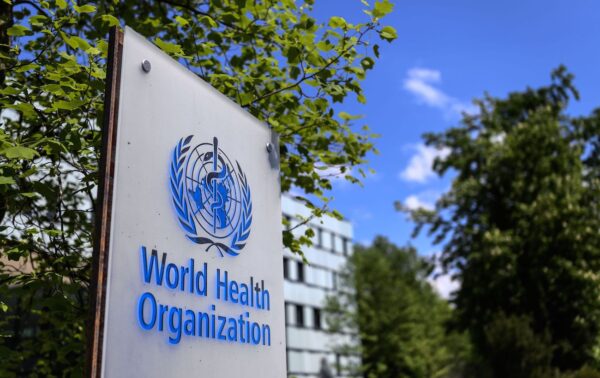
The idea gained steam in mid-February after WHO chief Tedros Adhanom Ghebreyesus contradicted his own agency’s report on the origin of the virus. The report ruled that a lab origin was “extremely unlikely,” while Tedros said that further investigation was needed. WHO’s investigation was marred by a lack of transparency from Beijing and the reported China ties of some of the investigators.
The month of May saw more reversals of the earlier trend to dismiss the lab origin theory, with Anthony Fauci, head of the U.S. National Institute of Allergy and Infectious Diseases, saying on May 11 that he is now “not convinced” that the virus developed naturally. His comments were in response to a question by a staff member of fact-checking website PolitiFact.
A few days later, PolitiFact quietly retracted a fact check it published in September 2020 in which it labelled as inaccurate and a “debunked conspiracy theory” the claim by a Hong Kong virologist at the time that COVID-19 originated in a lab. In May 2020, Fauci had dismissed the lab leak theory in a National Geographic interview, saying the evidence “strongly suggests” a natural origin.
On May 24, Vox amended an editor’s note on a March 2020 article that claimed the lab leak theory had been “debunked,” stating in its update that “scientific consensus has shifted.”
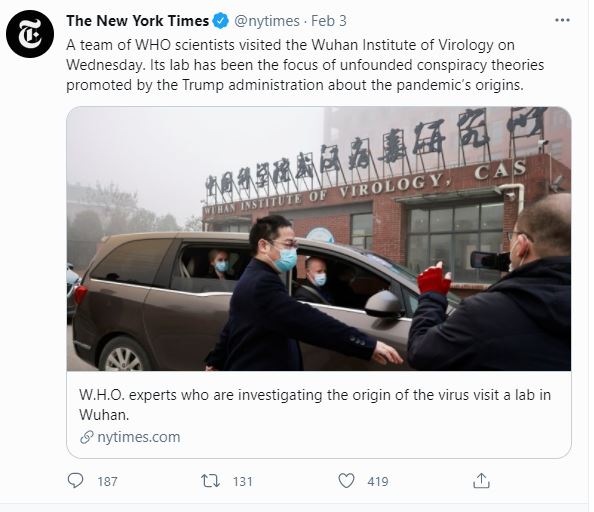
In the latest developments, the Biden administration said on May 25 that there should be a new “transparent” study into the virus origin, and the UK government said on May 24 that the WHO should “explore all possible theories” on origins of the virus.
Previously, 14 countries, including Canada and the United States, raised concerns about WHO’s study into the virus origin, asking for a “transparent and independent analysis and evaluation” in a March 30 statement. The former head of U.S. Centers for Disease Control and Prevention Robert Redfield said on March 26 that he believes the virus originated from a Chinese lab.
Citing a previously undisclosed U.S. intelligence report, a Wall Street Journal article published on May 23 reported that three researchers from China’s Wuhan Institute of Virology (WIV) sought hospital care with COVID-like symptoms in November 2019—about a month before the appearance of “patient zero” identified by the Chinese communist regime.
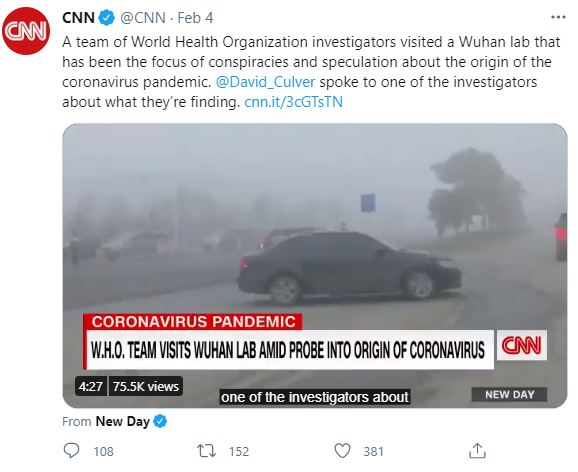
This revelation matches the contents of a fact sheet released by the U.S. State Department in the final days of the Trump administration, which said several WIV researchers became sick in the fall of 2019 with symptoms consistent with COVID-19.
Beijing was quick to dismiss the State Department’s claims in January as “conspiracy theories,” calling the fact sheet a “lie sheet.”
But communist China was hardly the only one to revert to “conspiracy” labelling throughout the pandemic. The New York Times, in a Feb. 3 Twitter post linking to its article on the WHO team’s visit to the WIV at the time, wrote, “[The WIV’s] lab has been the focus of unfounded conspiracy theories promoted by the Trump administration about the pandemic’s origins.” An article by CNN on the same day read, “A team of World Health Organization investigators in Wuhan are visiting a laboratory Wednesday that has been the focus of conspiracies and speculation about the origin of the coronavirus pandemic.”
Parliamentary Discussions
“Conspiracy” labelling and demands for an end to any questioning of the virus’s origin even extended to discussions in Canada’s Parliament.
This occurred during a Canada-China parliamentary committee meeting on May 10, at which MPs sought to get answers from administrators of the National Microbiology Laboratory (NML) in Winnipeg as to why scientists Xiangguo Qiu and her husband Keding Cheng and several Chinese students were escorted out of the lab in 2019.
The NML, like the Wuhan lab, is a facility rated at Level 4, the highest level of biosafety, equipped to work with the most deadly human and animal infectious diseases. It’s Canada’s only Level 4 lab.
At the meeting, Conservative foreign affairs critic Michael Chong tried to establish context about the MPs’ need for more details. He told the committee that Beijing has blocked investigations into the origin of the COVID-19 pandemic. He also pointed out that the NML had sent samples of deadly Ebola and Henipah viruses to China “just eight months before a global pandemic ostensibly began in the same city,” and that Qiu had travelled several times to the Wuhan National Biosafety Laboratory, which is part of the WIV. Chong added that Qiu and Cheng came under investigation by Canadian authorities and were eventually fired for policy breaches.
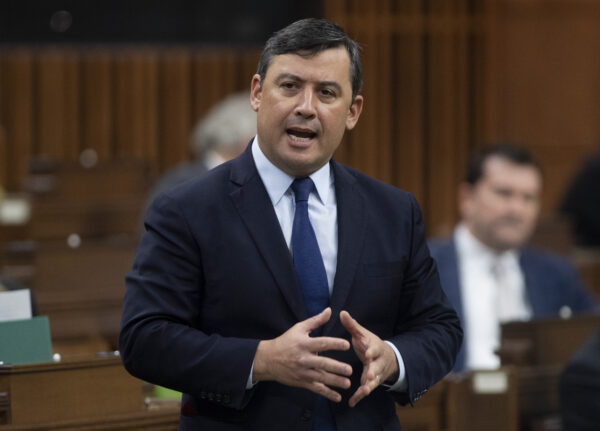
“The parallel between these two situations is appalling. We live in a parliamentary democracy and we are facing the same impediments to our investigations as investigators are facing as they attempt to discover the origins of the COVID-19 pandemic in China,” he said.
During points of order, Liberal MPs said Chong was alluding to conspiracies and objected to his statements connecting the virus origin issue with the investigations into the Winnipeg lab. One Liberal MP said Chong was “borrowing from some of the wildest theories on Facebook and other social media to make a point.”
Refuting the conspiracy labelling, Chong quoted a line from Eurasia Group president Ian Bremmer, whom he said is “anything but a conspiracy theorist.”
“China’s unwillingness to co-operate with the World Health Organization in investigating the coronavirus’s origins has made it impossible to substantiate how the disease came into existence, thereby obscuring the scientific response. Indeed, despite all the claims of conspiracy, the theory that COVID actually was inadvertently released from a Wuhan biolab remains both plausible and deeply concerning,” Chong quoted Bremmer as saying.
The NML’s administrators have so far continued their refusal to provide parliamentarians with the details on why the scientists were fired from Canada’s only Level 4 virology facility.
Influential Paper
One of the most influential documents early in the pandemic that shaped the discussion on the origin of the virus was a statement published by a group of scientists in the prestigious medical journal The Lancet on Feb. 19, 2020. Titled “Statement in support of the scientists, public health professionals, and medical professionals of China combatting COVID-19,” it stated: “We stand together to strongly condemn conspiracy theories suggesting that COVID-19 does not have a natural origin.”
The non-profit investigative research group U.S. Right to Know (USRTK) said in a November 2020 post that, according to documents it obtained under public record requests, the scientist who wrote the first draft of the statement was Peter Daszak, head of New York-based EcoHealth Alliance. USRTK said it was employees of Daszak’s organization—which has channelled U.S. government funding for coronavirus research at the Wuhan Institute of Virology—who organized the statement.

However, the statement published in The Lancet says, “We declare no competing interests.”
“Daszak lacks credibility because The Lancet letter of Feb. 19 that he drafted and organized falsely claimed no conflict of interest,” China scholar Anders Corr, publisher of Journal of Political Risk and an Epoch Times contributor, said in an email.
“In fact, Daszak’s organization helped fund research at the Wuhan Institute of Virology. That research was of coronaviruses.”
Daszak was also part of the WHO team that conducted a fact-finding mission into the origin of the virus in China earlier this year. And he was among the WHO experts who sparked controversy due to their ties to China. In addition to channelling U.S. National Institute of Health money to WIV, his organization received Chinese Communist Party (CCP) money, he said in a conference in 2018 at a conference sponsored by a Chinese state media.
Daszak didn’t respond to a request for comment from The Epoch Times.
Meanwhile, author and science journalist Nicholas Wade says that if the virus “had indeed escaped from research he funded, Dr. Daszak would be potentially culpable.” Wade was writing in a lengthy article published in the respected science journal Bulletin of Atomic Scientists, in which he established the reasons why the lab leak theory can’t be dismissed.
‘Poor Science’
Wade for many years was a staff member of The New York Times and the prestigious science journals Nature and Science. He said that another document influential in shaping the discourse on the virus’s origin and dismissing the lab leak theory was a March 17 letter by several scientists published in the journal Nature Medicine. The letter presents the authors’ reasoning for ruling out any alternative to a natural origin.
Disputing the reasoning in the letter, Wade says the claims are a case of “poor science.”
The Epoch Times contacted Kristian G. Andersen, the lead author of the Nature Medicine letter, but didn’t hear back.
Wade writes that the letters in The Lancet and Nature were political rather than scientific.
“The statements were designed to have a political effect, not to present the scientific facts,” he said in an email.
Among the reasons that a natural origin for the virus hasn’t yet been confirmed is that scientists still haven’t found evidence of the virus’s initial animal-to-human infection.
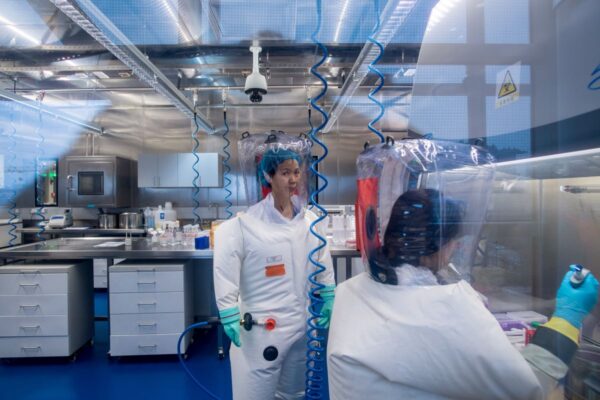
“The intermediary host species of SARS1 was identified within four months of the epidemic’s outbreak, and the host of MERS within nine months. Yet some 15 months after the SARS2 [SARS-CoV-2, which causes the COVDI-19 disease] pandemic began, and after a presumably intensive search, Chinese researchers had failed to find either the original bat population, or the intermediate species to which SARS2 might have jumped, or any serological evidence that any Chinese population, including that of Wuhan, had ever been exposed to the virus prior to December 2019,” Wade’s article says.
Wade says part of the problem causing many media to be quick in dismissing any theory besides a natural occurrence is that, unlike political reporters, science reporters aren’t fully vigilant of their source’s motives.
Another reason, he adds, “is the migration of much of the media toward the left of the political spectrum.”
“Because President Trump said the virus had escaped from a Wuhan lab, editors gave the idea little credence,” Wade said.
Data Access Denied
Many scientists and China scholars have repeatedly called on Beijing to allow proper investigation into the origin of the virus, which would help put an end to the divisive speculation.
But Corr says the regime has been able to steer the narrative on the origin by denying access to basic data.
“Our investigators and forensic virologists have not had full access to the data that is available in China. What they see is too often what the CCP wants them to see,” he says.
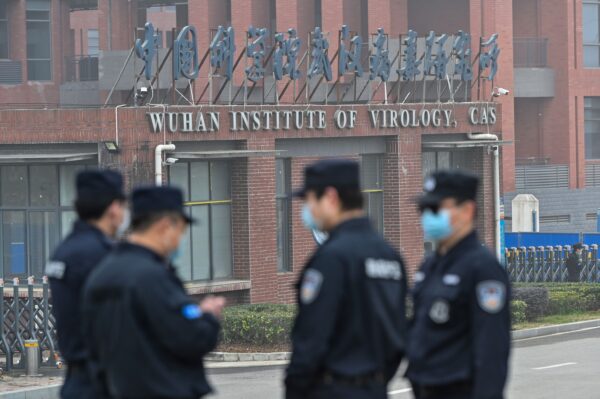
“So when our investigators walk away from an investigation in China saying ‘most of the evidence indicates against the lab leak hypothesis, and therefore the lab leak hypothesis is likely untrue,’ they are not using good scientific methodology.”
Marcus Kolga, a senior fellow with the Ottawa-based Macdonald-Laurier Institute and a disinformation expert, says regimes like those in China and Russia have departments with thousands of people dedicated to the creation and amplification of disinformation.
“It is certainly in the Chinese Communist Party’s interest to promote any narrative that casts doubt on the origin of the virus,” Kolga told The Epoch Times.
“If the virus did originate somewhere other than a wet market or elsewhere, I’m sure that the Chinese Communist Party will amplify any sort of narratives that would put that in doubt.”
He adds that early in the pandemic the Chinese regime hid information about the virus and didn’t take appropriate action to stop the spread.
“Had they acted earlier, we could have saved millions of lives.”
Racist Accusations a Political Tactic
Another way the regime has influenced the conversation on the pandemic, he says, is labelling any criticism of its conduct on the pandemic as racist.
Kolga says the CCP learned this tactic from the Soviet Union, which labelled anyone who was a critic of it as a fascist or neo-Nazi.
“These regimes understand that we are very sensitive to accusations of racism because of the diversity and the broad tolerance we have in this country. And then they engage in the use of such labels and such accusations in order to discredit any criticism of those regimes,” he says.
London, Ont.-based bar owner Alex Petro was the subject of scorn by multiple media reports and local politicians over a sign he put up at his bar that referred to the virus as “the China virus.” The criticism didn’t subside even after he clarified that his sign was to criticize the Chinese communist regime, which oppresses the Chinese people, and that he loves the people of China.
This attempt to cast as racist any criticism of China for its handling of the virus outbreak has appeared in social media advertisements by Chinese state media seen by millions.
There have also been efforts by Chinese officials to pin the blame for the virus on specific countries, including a claim by foreign ministry spokesman Zhao Lijian that the virus originated in the United States and was brought to Wuhan by the U.S. Army. The U.S. State Department summoned the U.S. ambassador over the incident.
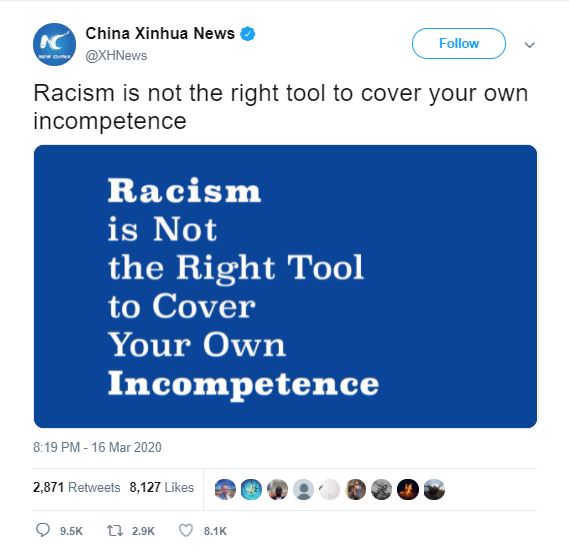
A recent report by the Brussels-based International Federation of Journalists said that Beijing has used its global media infrastructure “to seed positive narratives about China in national media, as well as mobilizing more novel tactics such as disinformation.”
Corr says that besides the CCP’s efforts, racism labels are also a result of communist and socialist influence in the West.
“Communist influence more generally—some of which has become organic to Western societies and some of which shades into democratic forms of socialism—has allied electorally with identity politics to become hyper-critical of race, gender, sexuality, post-colonial, and class issues,” he says.
Doing Proper Fact-Checking
Kolga says beside the extreme left, the extreme right is also a target of disinformation, with regimes such as those in China and Russia promoting conspiracy theories to polarize society and cause confusion. This could also result in pushing legitimate voices under the same labelling in order to discredit valid arguments.
The established advice for countering disinformation is to check reliable sources and to avoid solely relying on information on social media, where China and Russia are among countries known to be conducting major disinformation campaigns.
But when many established media get influenced by disinformation, the issue becomes more challenging.
Kolga recommends that journalists do proper fact-checking of all claims and also be informed about the background of the experts they speak to.
“Check their background, and where they’re connected with,” he says.
With reporting by Isabel Van Brugen, Frank Fang, and Zachary Stieber.


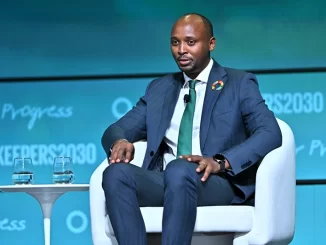
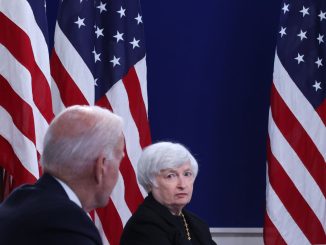

Be the first to comment